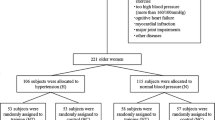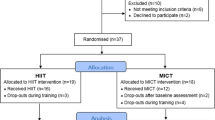Abstract
We evaluated the effects of different training frequencies on arterial stiffness. 77 elderly women (mean 68.8 years and 7.0 SD) were divided into two training (1DW and 2DW) and a CONTROL group (n = 23). 1DW (n = 29) participated in 90-min group training once a week for 12 weeks, while 2DW (n = 25) attended twice a week. Each training program included recreational activities, six to eight resistance exercises for circuit training, and leg exercises for chair-based exercise. Brachial systolic and diastolic blood pressures and the brachial-to-ankle pulse-wave velocity (baPWV) were obtained in the supine position. Muscle strength and ventilatory threshold were also measured. After the training program, a reduction (P < 0.01) in baPWV was observed in 2DW (−7.8 ± 7.0%) but not in 1DW (−1.5 ± 7.5%) and CONTROL (−0.4 ± 7.5%) without any changes in other measurements. The results suggest that, in order to improve arterial stiffness, an exercise frequency of at least twice a week is to be recommended for elderly.
Similar content being viewed by others
References
American College of Sports Medicine Position Stand (1998) Exercise and physical activity for older adults. Med Sci Sports Exerc 30:992–1008. doi:10.1097/00005768-199806000-00033
American College of Sports Medicine Position Stand (2004) Exercise and hypertension. Med Sci Sports Exerc 36:533–553. doi:10.1249/01.MSS.0000115224.88514.3A
American College of Sports Medicine, American Heart Association Joint Position Statement (1998) Recommendations for cardiovascular screening, staffing, and emergency policies at health/fitness facilities. Med Sci Sports Exerc 30:1009–1018. doi:10.1097/00005768-199806000-00034
Blair SN, Kohl HW, Barlow CE, Paffenbarger RS, Gibbons LW, Macera CA (1995) Changes in physical fitness and all-cause mortality. JAMA 273:1093–1098. doi:10.1001/jama.273.14.1093
Blumenthal JA, Emery CF, Madden DJ, Coleman RE, Riddle MW, Schniebolk S et al (1991) Effects of exercise training on cardiorespiratory function in men and women >60 years of age. Am J Cardiol 67:633–639. doi:10.1016/0002-9149(91)90904-Y
Charette SL, McEvoy L, Pyka G, Snow-Harter C, Guido D, Wiswell RA et al (1991) Muscle hypertrophy response to resistance training in older women. J Appl Physiol 70:1912–1916
Folkow B, Svanborg A (1993) Physiology of cardiovascular aging. Physiol Rev 73:725–764
Green JS, Crouse SF (1995) The effects of endurance training on functional capacity in the elderly: a meta-analysis. Med Sci Sports Exerc 27:920–926
Grimby G, Aniansson A, Hedberg M, Henning GB, Grangard U, Kvist H (1992) Training can improve muscle strength and endurance in 78- to 84-year-old men. J Appl Physiol 73:2517–2523
Kawano H, Tanaka H, Miyachi M (2006) Resistance training and arterial compliance: keeping the benefits while minimizing the stiffening. J Hypertens 24:1753–1759. doi:10.1097/01.hjh.0000242399.60838.14
Karvonen M, Kentala E, Mustala O (1957) The effects of training on heart rate; a longitudinal study. Ann Med Exp Biol Fenn 35:307–315
Lakatta E (2002) Age-associated cardiovascular changes in health: impact on cardiovascular disease in older persons. Heart Fail Rev 7:29–49. doi:10.1023/A:1013797722156
Langille B, O’Donnell F (1986) Reductions in arterial diameter produced by chronic decreases in blood flow are endothelium-dependent. Science 231:405–407. doi:10.1126/science.3941904
Liao D, Arnett DK, Tyroler HA, Riley WA, Chambless LE, Szklo M et al (1999) Arterial stiffness and the development of hypertension. The ARIC study. Hypertens 34:201–206
Maeda S, Miyauchi T, Kakiyama T, Sugawara J, Iemitsu M, Irukayama-Tomobe Y et al (2001) Effects of exercise of 8 weeks and detraining on plasma levels of endothelium-derived factors, endhothelin-1 and nitric oxide, in healthy young humans. Life Sci 69:1005–1016. doi:10.1016/S0024-3205(01)01192-4
Matsui Y, Kario K, Ishikawa J, Eguchi K, Hoshide S, Shimada K (2004) Reproducibility of arterial stiffness indices (pulse wave velocity and augmentation index) simultaneously assessed by automated pulse wave analysis and their associated risk factors in essential hypertensive patients. Hypertens Res 27:851–857. doi:10.1291/hypres.27.851
Miura H, Aoki S (2005) Influence of low-intensity circuit training on artery stiffness in female [in Japanese, English abstract]. Jpn J Phys Fit Sports Med 54:205–210
Miyachi M, Kawano H, Sugawara J, Takahashi K, Hayashi K, Yamazaki K et al (2004) Unfavorable effects of resistance training on central arterial compliance—a randomized intervention study. Circulation 110:2858–2863. doi:10.1161/01.CIR.0000146380.08401.99
Monahan K, Tanaka H, Dinenno F, Seals D (2001) Central arterial compliance is associated with age- and habitual exercise-related differences in cardiovagal baroreflex sensitivity. Circulation 104:1627–1632. doi:10.1161/hc3901.096670
Moncada S, Palmer RM, Higgs EA (1991) Nitric oxide: physiology, pathophysiology, and pharmacology. Pharmacol Rev 43:109–142
Nakamura Y, Tanaka K, Yabushita N, Sakai T, Shigematsu R (2007) Effects of exercise frequency on functional fitness in older adult women. Arch Gerontol Geriatr 44:163–173. doi:10.1016/j.archger.2006.04.007
Paffenbarger RS, Wing AL, Hyde RT, Jung DL (1983) Physical activity and incidence of hypertension in college alumni. Am J Epidemiol 117:245–257
Palmer RMJ, Ferrige AG, Monvada S (1987) Nitric oxide release accounts for the biological activity of endothelium-derived relaxing factor. Nature 327:347–353. doi:10.1038/327524a0
Rudic R, Sheseley E, Maeda N, Smithies O, Segal S, Sessa W (1998) Direct evidence for the importance of endothelium-derived nitric oxide in vascular remodeling. J Clin Invest 101:731–736. doi:10.1172/JCI1699
Seals DR (2003) Habitual exercise and the age-associated decline in large artery compliance. Exerc Sport Sci Rev 31:68–72. doi:10.1097/00003677-200304000-00003
Sessa WC, Pritchard K, Seyedi N, Wang J, Hintze TH (1994) Chronic exercise in dogs increases coronary vasucular nitric oxide production and endothelial cell nitric oxide synthase gene expression. Circ Res 74:349–353
Stiggelbout M, Popkema DY, Hopman-Rock M, De Greef M, Van Mechelen W (2004) Once a week is not enough: effects of a widely implemented group based exercise programme for older adults; a randomized controlled trial. J Epidemiol Community Health 58:83–88. doi:10.1136/jech.58.2.83
Sugawara J, Inoue H, Hayashi K, Yokoi T, Kono I (2004) Effects of low-intensity aerobic exercise training on arterial compliance in postmenopausal women. Hypertens Res 27:897–901. doi:10.1291/hypres.27.897
Tanaka H, DeSouza CA, Seals DR (1998) Absence of age-related increase in central arterial stiffness in physically active women. Arterioscler Thromb Vasc Biol 18:127–132
Tanaka H, Dinenno FA, Monahan KD, Clevenger CM, DeSouza CA, Seals DR (2000) Aging, habitual exercise, ans dynamic arterial compliance. Circulation 102:1270–1275
Tronc F, Wassef M, Esposito B, Henrion D, Glagov S, Tedgui A (1996) Role of NO in flow-induced remodeling of the rabbit common carotid artery. Arterioscler Thromb Vasc Biol 16:1256–1262
Vaitkevicius PV, Fleg JL, Engel JH, O’Connor FC, Wright JG, Lakatta LE et al (1993) Effects of age and aerobic capacity on arterial stiffness in healthy adults. Circulation 88:1456–1462
Wasserman K, Whipp B, Koyal S, Beaver W (1973) Anaerobic threshold and respiratory gas exchange during exercise. J Appl Physiol 35:236–243
Acknowledgments
We thank David A House, Katherine Osgood, Saori Maruoka, Junko Hiroe, Kazuya Harada, Eri Yoshida, and Nao Okumura for their technical assistance in this study. This study was supported by a Grant-in Aid for Scientific Research from the Ministry of Education, Science, Sports and Culture of Japan (15700441).
Author information
Authors and Affiliations
Corresponding author
Rights and permissions
About this article
Cite this article
Miura, H., Nakagawa, E. & Takahashi, Y. Influence of group training frequency on arterial stiffness in elderly women. Eur J Appl Physiol 104, 1039–1044 (2008). https://doi.org/10.1007/s00421-008-0860-1
Accepted:
Published:
Issue Date:
DOI: https://doi.org/10.1007/s00421-008-0860-1




